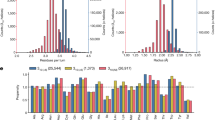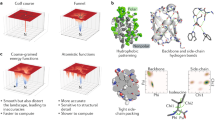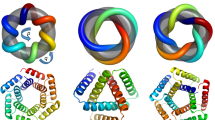Abstract
Here we report the creation of a predominantly β-structured mini-protein motif. The design target is based on the naturally occurring toxin hand (TH) motifs that are composed of four disulfide bonds and three loops that form a 'hand'. Analysis and subsequent modification of several generations of mini-proteins produced the final 29-residue mini-protein. The structured motif of this new mini-protein provides insight into the compensatory changes that result in the formation of a tightly packed hydrophobic core in a small, globular β-structure motif. Additionally, this mini-motif represents a new, distinct surface topology for protein design and a valuable, yet compact, model system for the study of β-sheet structure in water.
This is a preview of subscription content, access via your institution
Access options
Subscribe to this journal
Receive 12 print issues and online access
$189.00 per year
only $15.75 per issue
Buy this article
- Purchase on Springer Link
- Instant access to full article PDF
Prices may be subject to local taxes which are calculated during checkout




Similar content being viewed by others
References
Cunningham, B.C. & Wells, J.A. Curr. Opin. Struct. Biol. 7, 457–462 (1997).
Imperiali, B. & Ottesen, J.J. J. Peptide Res. 54, 177–184 (1999).
DeGrado, W.F., Summa, C.M., Pavone, V., Nastri, F. & Lombardi, A. Annu. Rev. Biochem. 68, 779–819 (1999).
Gellman, S.H. Curr. Opin. Chem. Biol. 2, 717–725 (1998).
Lacroix, E. et al. Curr. Opin. Struct. Biol. 9, 487–493 (1999).
Schenck, H.L. & Gellman, S.H. J. Am. Chem. Soc. 120, 4869–4870 (1998).
Sharman, G.J. & Searle, M.S. J. Am. Chem. Soc. 120, 5291–5300 (1998).
Kortemme, T., Ramierez-Alvarado, M. & Serrano, L. Science 281, 253–256 (1998).
Kraulis, P.J. et al. Biochemistry 28, 7241–7257 (1989).
Endo, T. & Tamiya, N. In International encyclopedia of pharmacology and therapeutics: snake toxins (ed. Harvey, A.L.) 165–222 (Pergamon Press, New York; 1991).
Falkenstein, R.J., Pena, C. & Bonino, M.J.B.D. Int. J. Pept. Prot. Res. 47, 167–176 (1996).
Hutchinson, E.G. & Thornton, J.M. Protein Sci. 3 2207–2216 (1994).
Stanger, H.E. & Gellman, S.H. J. Am. Chem. Soc. 120, 4236–4237 (1998).
Merkel, J.S. & Regan, L. Folding Des. 3, 449–455 (1998).
Smith, C.K. & Regan, L., Science, 270, 980–982 (1995).
Wouters, M.A. & Curmi, P.M.G. Protein Struct. Func. Genet. 22, 119–131 (1995).
Wishart, D.S., Sykes, B.D. & Richards, F.M. Biochemistry 31, 1647–1651 (1992).
Chongwoo, A.K. & Berg, J.A. Nature 362, 267–270 (1993).
Leszczynski, J.F. & Rose, G.D. Science 234, 849–855 (1986).
Fetrow, J. FASEB J. 9, 708–717 (1995).
Han, Y.X., Albericio, F. & Barany, G. J. Org. Chem. 62, 4307–4312 (1997).
Laue, T.M., Shah, B.D., Ridgeway, T.M. & Pelletier, S.L. In Analytical ultracentrifugation in biochemistry and polymer science (eds Harding, S.E., Rowe, A.J. & Horton, J.C.) 90–125 (Royal Society of Chemistry, Cambridge, UK; 1992).
Struthers, M.D., Ottesen, J.J. & Imperiali, B. Folding Des. 3, 95–104 (1998).
Kraulis, P.J. J. Appl. Crystallogr. 24, 946–950 (1991).
Laskowski, R.A., Rullman, J.A.C., MacArthur, M.W., Kaptein, R. & Thornton, J.M. J. Biomol. NMR, 8 (1996).
Acknowledgements
This research was supported by the NSF. The award of NSF predoctoral fellowship to J.J.O., the Multiuser Facility for the Study of Complex Macromolecular Systems, the Francis Bitter Magnet Labs and the Department of Chemistry Instrumentation Facility are also gratefully acknowledged.
Author information
Authors and Affiliations
Corresponding author
Rights and permissions
About this article
Cite this article
Ottesen, J., Imperiali, B. Design of a discretely folded mini-protein motif with predominantly β-structure. Nat Struct Mol Biol 8, 535–539 (2001). https://doi.org/10.1038/88604
Received:
Accepted:
Issue Date:
DOI: https://doi.org/10.1038/88604



